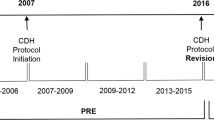Abstract
Objective:
To analyze operative repair, extracorporeal membrane oxygenation (ECMO) and survival rates based on highest pre-ductal oxygen saturation (Pre-O2SAT) in a large infant cohort reported to Congenital Diaphragmatic Hernia Study Group Registry between 2000 and 2010.
Study Design:
Analyzed data included gestational age, birth weight, defect side and size, repair, ECMO use, survival and highest reported PaO2 and Pre-O2SAT in first 24 h of life. We excluded 614 infants due to severe anomaly. Pre-O2SAT data were available for 1672 infants.
Result:
Among infants with highest Pre-O2SAT value <85%, survival (24/105=23%) and repair (55/105=52%) rates were significantly decreased compared with infants with higher values. Survival increased to 44% for infants with highest Pre-O2SAT<85% who underwent operative repair. Of these, 83% (20/24) required ECMO support compared with 15% (144/961) of survivors with Pre-O2SAT>99% (P<0.001). The lowest reported Pre-O2SAT with survival was 32% and for survival without ECMO was 52%.
Conclusion:
A reported highest Pre-O2SAT<85% in the first 24 h of life was not uniformly fatal; but survival of infants with Pre-O2SAT<85% was associated with high ECMO use and prolonged hospitalization.
This is a preview of subscription content, access via your institution
Access options
Subscribe to this journal
Receive 12 print issues and online access
$259.00 per year
only $21.58 per issue
Buy this article
- Purchase on Springer Link
- Instant access to full article PDF
Prices may be subject to local taxes which are calculated during checkout



Similar content being viewed by others
References
Cannon C, Dildy GA, Ward R, Varner MW, Dudley DJ . A population-based study of congenital diaphragmatic hernia in Utah: 1988–1994. Obstet Gynecol 1996; 87: 959–963.
Colvin J, Bower C, Dickinson JE, Sokol J . Outcomes of congenital diaphragmatic hernia: a population-based study in Western Australia. Pediatrics 2005; 116: e356–e363.
Stege G, Fenton A, Jaffray B . Nihilism in the 1990s: the true mortality of congenital diaphragmatic hernia. Pediatrics 2003; 112: 532–535.
Wung JT, Sahni R, Moffitt ST, Lipsitz E, Stolar CJ . Congenital diaphragmatic hernia: survival treated with very delayed surgery, spontaneous respiration, and no chest tube. J Pediatr Surg 1995; 30: 406–409.
Boloker J, Bateman DA, Wung JT, Stolar CJ . Congenital diaphragmatic hernia in 120 infants treated consecutively with permissive hypercapnea/spontaneous respiration/elective repair. J Pediatr Surg 2002; 37: 357–366.
Bohn D . Congenital diaphragmatic hernia. Am J Respir Crit Care Med 2002; 166: 911–915.
Kays DW, Langham Jr MR, Ledbetter DJ, Talbert JL . Detrimental effects of standard medical therapy in congenital diaphragmatic hernia. Ann Surg 1999; 230: 340–348; discussion 348–351.
Downard CD, Jaksic T, Garza JJ, Dzakovic A, Nemes L, Jennings RW, Wilson JM . Analysis of an improved survival rate for congenital diaphragmatic hernia. J Pediatr Surg 2003; 38: 729–732.
Frenckner B, Ehren H, Granholm T, Linden V, Palmer K . Improved results in patients who have congenital diaphragmatic hernia using preoperative stabilization, extracorporeal membrane oxygenation, and delayed surgery. J Pediatr Surg 1997; 32: 1185–1189.
Hoffman SB, Massaro AN, Gingalewski C, Short BL . Survival in congenital diaphragmatic hernia: use of predictive equations in the ECMO population. Neonatology 2011; 99: 258–265.
Tsao K, Lally KP . The Congenital Diaphragmatic Hernia Study Group: a voluntary international registry. Semin Pediatr Surg 2008; 17: 90–97.
Schultz CM, DiGeronimo RJ, Yoder BA . Congenital diaphragmatic hernia: a simplified postnatal predictor of outcome. J Pediatr Surg 2007; 42: 510–516.
Graziano JN . Cardiac anomalies in patients with congenital diaphragmatic hernia and their prognosis: a report from the Congenital Diaphragmatic Hernia Study Group. J Pediatr Surg 2005; 40: 1045–1049; discussion 1049–1050.
Sweed Y, Puri P . Congenital diaphragmatic hernia: influence of associated malformations on survival. Arch Dis Child 1993; 69: 68–70.
Raval MV, Wang X, Reynolds M, Fischer AC . Costs of congenital diaphragmatic hernia repair in the United States-extracorporeal membrane oxygenation foots the bill. J Pediatr Surg 2011; 46: 617–624.
Logan JW, Cotten CM, Goldberg RN, Clark RH . Mechanical ventilation strategies in the management of congenital diaphragmatic hernia. Semin Pediatr Surg 2007; 16: 115–125.
Author information
Authors and Affiliations
Consortia
Corresponding author
Ethics declarations
Competing interests
The authors declare no conflict of interest.
Rights and permissions
About this article
Cite this article
Yoder, B., Lally, P., Lally, K. et al. Does a highest pre-ductal O2 saturation <85% predict non-survival for congenital diaphragmatic hernia?. J Perinatol 32, 947–952 (2012). https://doi.org/10.1038/jp.2012.18
Received:
Revised:
Accepted:
Published:
Issue Date:
DOI: https://doi.org/10.1038/jp.2012.18
Keywords
This article is cited by
-
Congenital diaphragmatic hernia
Nature Reviews Disease Primers (2022)
-
Milrinone in congenital diaphragmatic hernia – a randomized pilot trial: study protocol, review of literature and survey of current practices
Maternal Health, Neonatology and Perinatology (2017)
-
Survival prediction of high-risk outborn neonates with congenital diaphragmatic hernia from capillary blood gases
BMC Pediatrics (2016)


